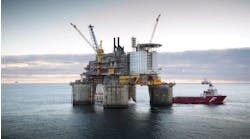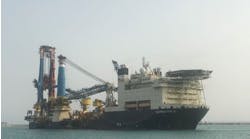Modern flow assurance methods: clogged pipelines, wax deposition, hydrate plugs
Annular flow velocity distribution.
PART I: This is the first in a three-part series on flow assurance principles and methods. This segment deals with clogged pipelines, wax deposition, and hydrate plugs. Part II will focus on physical properties and engineering application, and Part III will deal with coupled velocity and temperature fields in bundled pipelines.
Strong industry interest in deepwater exploration and production has elevated the importance of reliable flow assurance modeling. No longer does pipe flow analysis mean "pressure versus flow rate" for simple Newtonian fluids (or maybe, even power law flows) in ideal circular cross-sections.
In the hostile ocean environment, wax deposition along cold pipe walls and hydrate formation can easily lead to clogging and reduced flow. Because stoppage points are difficult to locate, and not easily accessible once they are found, even the least significant blockage effects imply millions of dollars in potential remedial work.
For these reasons, pipeline constructors now address realistic plugging scenarios in which large blockages are present. What are the flow consequences for "half-blocked" pipes? How is "wax deposition," which attaches circumferentially to portions of pipe walls, dynamically different from hydrate "plug formation" created in isolation? What are their flow rate consequences?
Deepwater operators are more concerned with plugging than surface operators because the lack of accessibility and the use of smaller pigs increase the economic severity of plugging events. This makes it important to understand the practical consequences and benefits of understanding "fluid rheology." Simply, rheology is the science of non-ideal fluid behavior. Rheological considerations appear in food processing, wire coatings, manufacturing extrusions, and other applications.
Here, the questions that arise are practical enough. For different kinds of production fluids, will the pipeline tend to be "self-cleaning" in the sense that the flow itself erodes debris accumulations? Or will it clog? Will gelling due to temporary flow stoppages lead to difficulties in startup, especially when geometric cross-sections contain anomalous blockages?
And what are the dynamic effects of "pipeline bundles," that is, the "heated pipes within pipes" used to maintain elevated flow temperatures? Here, normal duct flows are replaced by non-ideal eccentric annular flows, and transport coefficients, such as viscosity and yield stress, vary throughout the cross-section due to non-uniform heating. Changes in delivery rate and heat transfer considerations obviously affect planning models and delivery economics.
It is clear that traditional pipe flow analysis methods no longer suffice in the new environment. Much more comprehensive studies are needed to anticipate potential operational problems, investigations that require sophisticated math models with broad geometric and rheological simulation capabilities. This three-part series describes recent advances in "computational rheology" and its application to real-world problems.
Background
Cuttings transport correlations.
From a simulation perspective, the ability of "the model" to capture important geometric details cannot be underestimated. Very often, this means the difference between results offering "pleasing graphics" only, versus those that really predict dangerous conditions and offer remediation alternatives.
The pipeline technology described here originated from related experience in horizontal well hole-cleaning. In the late 1980s, drillers found that the velocity criteria successfully used to flush vertical wells no longer worked at high deviation angles. Simplified "slot flow" and "narrow annulus" models completely failed in correlating experimental and field data, but it turned out that this failure arose because the mathematical method used to develop practical guidelines was flawed.
In a series of 1990-1991 articles presented several years ago, the author showed that by solving the non-Newtonian rheological models for realistic Power Law, Bingham Plastic, and Herschel-Bulkley fluids on the exact flow domains themselves - without geometric approximation - all published results for hole-cleaning lead to a simple physical principle for hole-cleaning.
The resulting "stress law" is easily explained. Essentially, debris beds in horizontal wells possess well-defined mechanical yield stresses that can be eroded when sufficient viscous shear forces are applied (cuttings transport efficiency correlates with the stress level acting over the cuttings bed). This was demonstrated with a numerical "finite difference" model employing an exact "boundary conforming, curvilinear grid" system, which was used to study the extensive experimental data set obtained at the University of Tulsa.
The results were summarized and published in the 1991 book "Borehole Flow Modeling." Since then, the "stress law" has been adopted widely. The adjacent figure displays exact calculated velocity profiles for a highly eccentric annulus; the new methodology also allowed users to simulate the effects of cuttings beds, washouts, and square drill collars very easily. The following figure shows the strong correlation between "cuttings concentration" and "mean viscous stress" obtained for the University of Tulsa database.
With this success, it was natural to consider extending the computational methodology to "pipe" (as opposed to "annular") flows, particularly, to real-world, non-circular geometries with obstructions. For example, is it possible to generate curvilinear grids quickly, and solve the flow equations for different types of non-Newtonian fluid rheologies equally fast?
Can this technology be made accessible to users with no prior experience in computer simulation or fluid-dynamics? Is it possible to display calculated physical properties like shear rate, viscous stress, and shear rate - attributes important to interpreting experimental data - quickly in color, in order to facilitate real-time understanding and engineering analysis? The answers, fortunately, are "yes."
The present three-part series describes various highlights from recent researches and client investigations. A particularly interesting pipe geometry is shown above where the usual circular cross-section is blocked by a large obstacle representing a "worst case" hydrate plug.
The curvilinear grid shown superimposed on the flow domain demonstrates how the coordinate system "captures" all the salient physical features of the plug. The "red" zones, for example, reveal high velocities at the left, while "blue" indicates lower velocities associated with the no-slip condition. Similar diagrams are available for physical properties such as shear rate and stress.
Although the algorithms developed in "Borehole Flow Modeling" were fast, requiring just minutes on typical personal computers, they were still not "ideal," because practical engineering applications require dozens (if not hundreds) of "what-if" analyses per hour. This bottleneck would be solved by applying complex variables methods, traditionally used for linear equations, to the nonlinear ones governing our geometric mappings.
This high-risk research was funded by the United States Department of Energy in 1999, and led to the development of schemes that not only generated the required grid systems, but solved the nonlinear rheological equations and displayed computed results as well - in seconds. This technology is now available to practicing engineers in software that is Windows-compatible. Let us turn to two very important applications.
Model applications
One important engineering application deals with the dynamics of pipe clogging, for instance, the formation and possible erosion of wax deposits in time. This "fluids-and-solids interaction" requires additional information from carefully controlled laboratory experiments. In this setting, wax growth and erosion are accurately monitored as a function of well-defined external parameters, and the results are nondimensionalized to extend their range of validity.
While the exact model used is proprietary to the client company, one can clearly state that constitutive models describing fluids and solids interaction take an almost universal form: "If (computed) shear stress exceeds known wax yield stress, erosion will result. However, if it does not, deposition will occur."
Time-lapse "snapshots" of velocity field in clogging pipe.
Similar rules apply to hydrate growth and erosion. The exact rates will depend on the physical mechanisms assumed (buoyancy, centrifugal force due to bends, cohesion characteristics, weighting material particle size and number density, and so on). Transient simulations begin by assuming an ideal circular geometry containing a slow-moving non-Newtonian fluid. The associated low-stress environment allows wax to deposit, accumulating from one side of the pipe to the other.
After one time-step, the circular profile changes due to incremental deposition, and fluid flow attributes are recalculated for the new geometry. Then, the updated wall stress is used to evaluate additional changes in wax buildup. The time-lapse "snapshots" of the velocity field clearly show how the pipe clogs with time under constant pressure gradient action. Interestingly, the loss of 50% flow area in this case resulted in a flow rate decrease of over 80%.
Of course, similar studies can be pursued to study the opposite situation involving erosion. A practical end objective may focus on determining the minimum amount of chemical additives needed to ensure "self-cleaning" action. Clearly, popular "thermodynamics only" approaches to wax deposition and hydrate formation represent only half the story. The "other half" is told by dynamic analysis, which requires computational rheology coupled with well-defined flow-loop modeling.
Recirculating vortex in flow with density stratification.
The above calculations assume that fluid density is uniform. However, this may not be true when solids have settled due to gravity segregation, a result of slow movement or temporary production stoppages. Whenever density stratification is found perpendicular to the flow direction, isolated "recirculating vortexes" can form within the flow domain. One possible configuration is shown in the streamline "snapshot," the result of computer simulations allowing density gradients.
Thus, even when flow solids are not apparent, fluid structures can evolve that effectively block the flow as if "real blockages" themselves were present. Such localized flows, when they additionally entrain debris, can abrasively erode pipeline metal. In one case, this mechanism was responsible for large-scale damage to a process plant operated by a major oil company.
The severe economic consequences associated with clogged pipelines require a new level of rigor in analysis beyond the traditional. Modern simulation algorithms that treat complicated rheologies, modeling not just flows in geometrically complex shapes, but duct cross-sections that change and react dynamically are necessary. These methods offer the prospect that "real-world" simulation in a hostile ocean environment is achievable, and also new optimism for reducing the likelihood of catastrophic operational problems associated with pipeline clogging. ;
References
Chin, W.C., Borehole Flow Modeling, Gulf Publishing, Houston, 1991.
Chin, W.C., Computational Rheology for Pipeline and Annular Flow, Gulf Publishing, Houston, 2000.
Acknowledgment
Brown & Root Energy Services and Halliburton Energy Services helped develop solids deposition models (Raj Amin, Ron Morgan, Harry Smith, and Tin Win). Advanced mapping research and convergence acceleration methods were funded by the United States Department of Energy (Grant No. DE-FG03-99ER82895).
Author
Wilson C. Chin ([email protected]) earned his PhD. at MIT and his MSc from Cal Tech. He is affiliated with StrataMagnetic Software, LLC (Houston, Texas) and conducts research on computational rheology, reservoir flow analysis, electromagnetic modeling, and software development. He has published 50 related papers, holds 20 oilfield patents, and has authored five books on petroleum applications.







